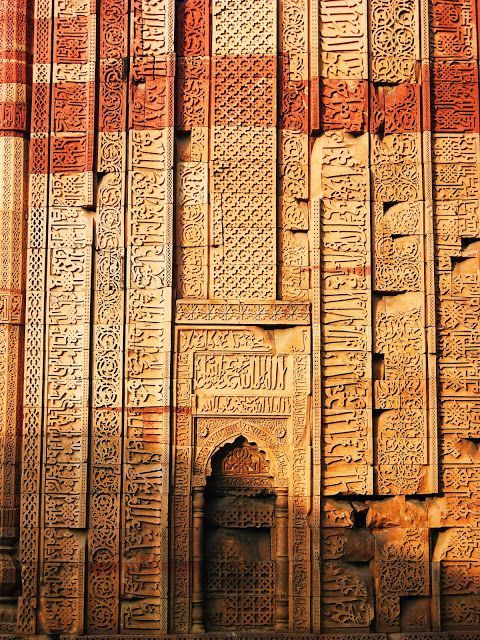#Qutb Complex
Text
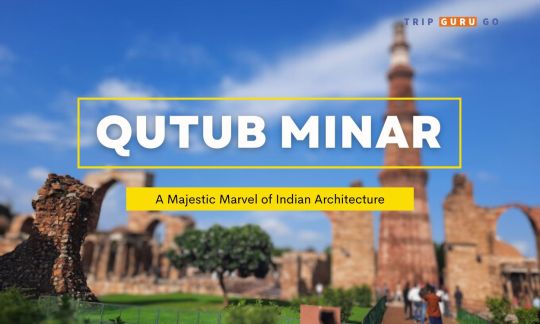
#Qutub Minar#Indian Architecture#UNESCO World Heritage Site#Delhi#India#Indo-Islamic Architecture#Historical Landmark#12th Century Monument#Majestic Tower#Cultural Heritage#Tourist Attraction#Architectural Marvel#Delhi Sightseeing#Qutb Complex#Delhi Tourism#Heritage Conservation
0 notes
Text
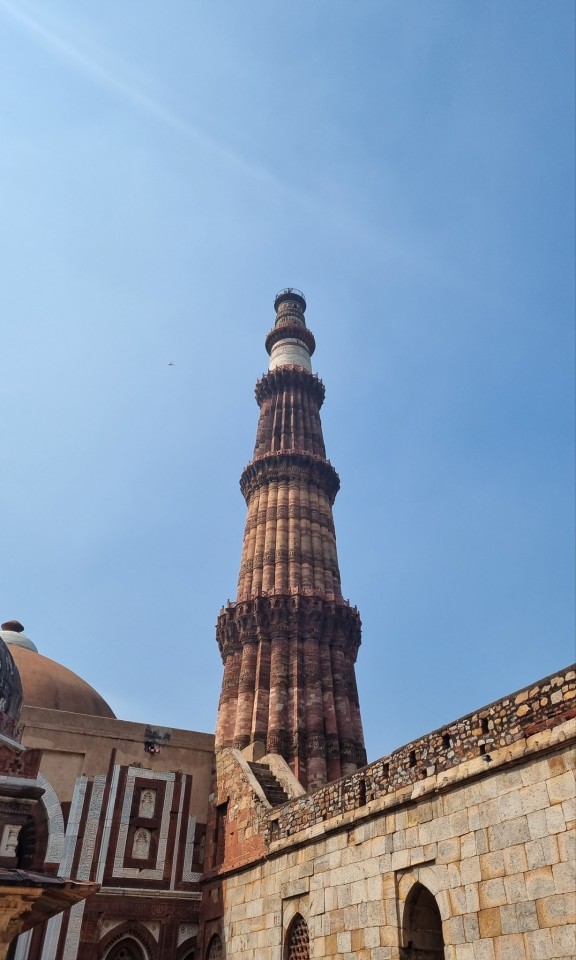
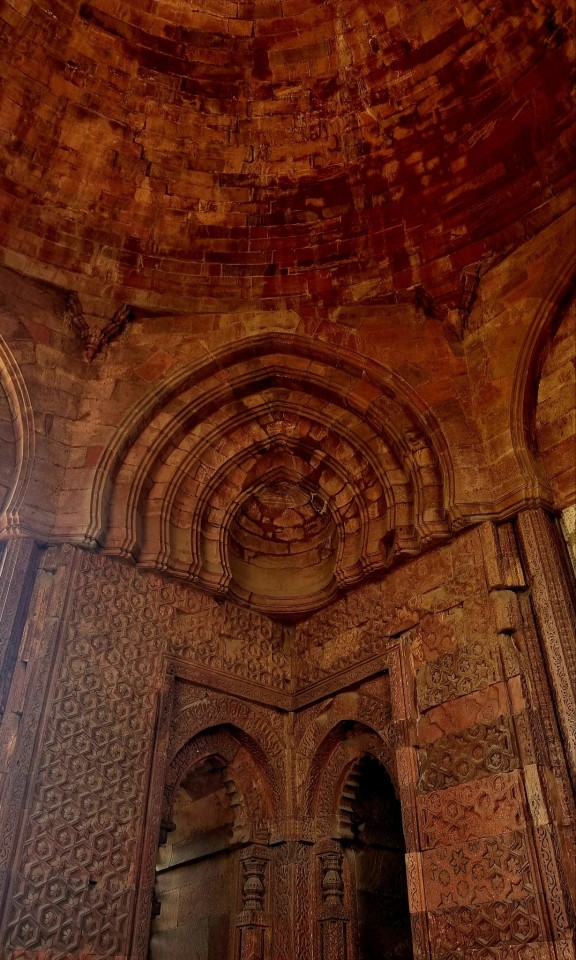
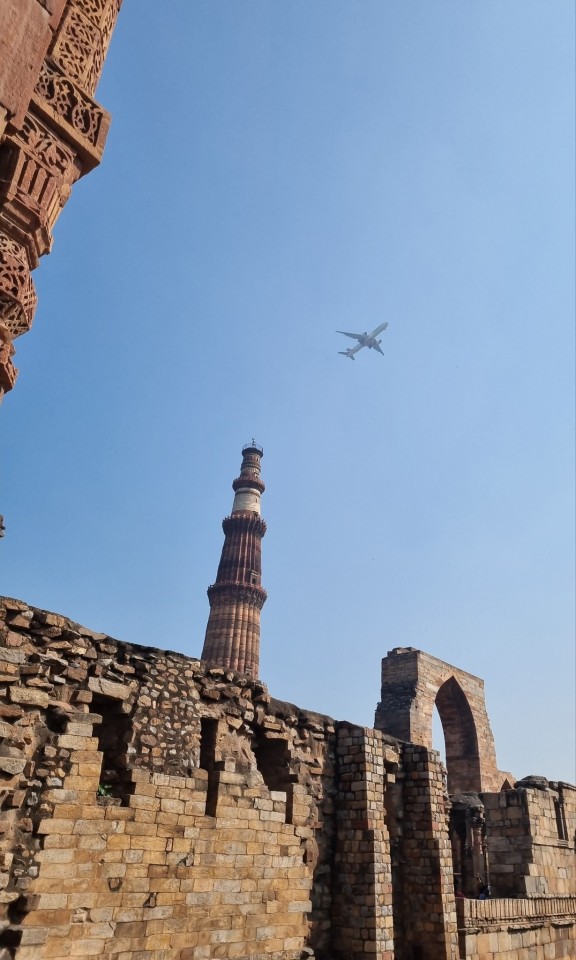
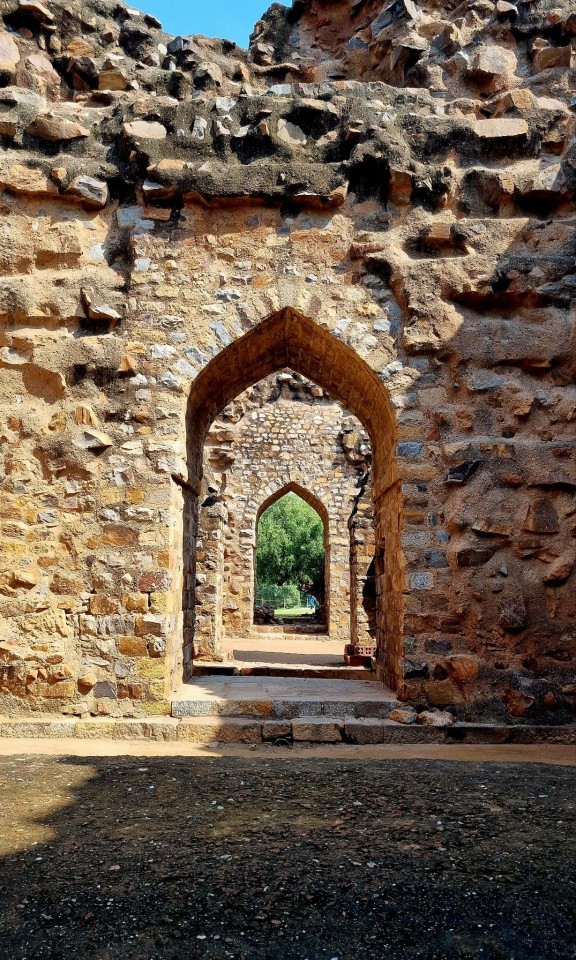
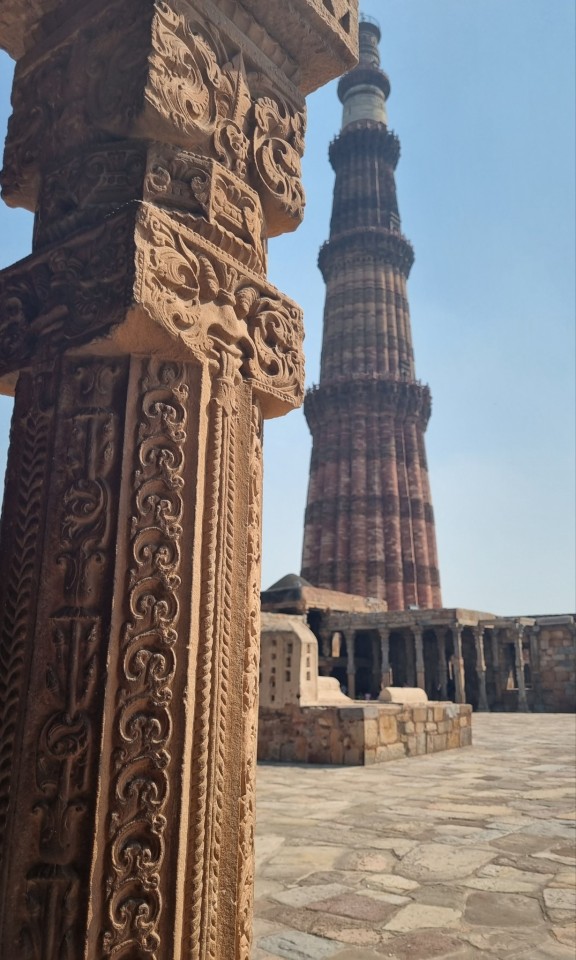


Please like or repost if downloading. Please give credit if you're sharing it online.
#qutub minar#history#monuments#dilli#delhi#new delhi#india#cultural#asia#delhi sultanate#mughals#mehrauli#qutub complex#indo islamic architecture#qutb ud din aibak#iltutmish#tughlaq dynasty#lodi dynasty#wallpaper#historical wallpapers#phone wallpapers#indian monuments#historical monuments#for you#trending#tumblr
8 notes
·
View notes
Text
The ancient Iron Pillar of Dehli, which was forged with exceptionally pure iron and is resistant to rust, reflects the remarkable skill of the metallurgists of ancient India.
28 notes
·
View notes
Photo
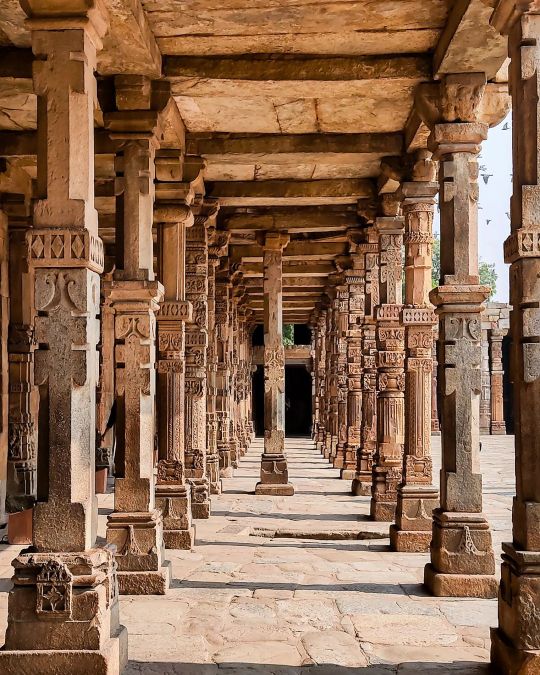
Carved pillar passage Qutub Complex The Indian Slave Dynasty (Mamluk Dynasty) lasted from 1206 to 1290, almost a century. The list of sultans is as follows Qutb ud-Din Aibak (1206 – 1210 AD) Aram shah (1210 – 1211 AD) Iltutmish (1211 – 1236 AD) Rukn-ud-din-Firoz (1236 AD) Razia al-Din (1236 – 1240 AD) Muiz-ud-din Bahram (1240 – 1242 AD) Ala-ud-din Masud (1242 – 1246 AD) Nasir-ud-din Mahmud (1246 – 1266 AD) Ghiyas-ud-din Balban (1266 – 1285 AD) Muiz-ud-din Muhammad Qaiqabad (1286 – 1290 AD) #qutubminar #delhi #worldheritagesite #history #carving #stonestructures #stonecarving #historyofindia #slavedynasty #lalkot #qutubcomplex #window #ancientmarvels #india #phonephotography #photography #mumbai #maharashtra #redsandstone #marble #delhidiaries #quwwatulislammosque # (at Qutub Minar) https://www.instagram.com/p/Cl2wjWHykQV/?igshid=NGJjMDIxMWI=
#qutubminar#delhi#worldheritagesite#history#carving#stonestructures#stonecarving#historyofindia#slavedynasty#lalkot#qutubcomplex#window#ancientmarvels#india#phonephotography#photography#mumbai#maharashtra#redsandstone#marble#delhidiaries#quwwatulislammosque
3 notes
·
View notes
Text
The 8 Beautiful Places to Visit in the Golden Triangle
The Golden Triangle Tour in India is a captivating journey spanning Delhi, Agra, and Jaipur, forming a triangle on the map. Each destination is steeped in rich history, cultural splendor, and architectural marvels. From the bustling streets of Delhi to the iconic Taj Mahal in Agra, and the majestic forts of Jaipur, this tour offers an immersive experience into India's diverse heritage and vibrant traditions. Discover the Mughal grandeur, Rajputana opulence, and modern Indian life, all in one exhilarating expedition.
Here are eight beautiful places you must visit while exploring the Golden Triangle:
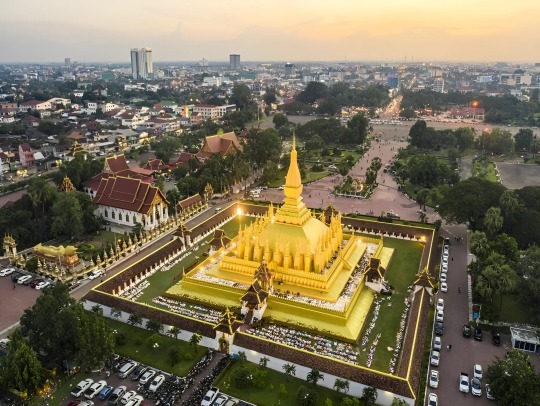
1. Taj Mahal, Agra:
One of the most iconic landmarks in the world, the Taj Mahal is a white marble mausoleum built by Mughal Emperor Shah Jahan in memory of his wife Mumtaz Mahal. Its beauty is unmatched, especially during sunrise and sunset.
Also Read: Kazakhstan tour package
2. Agra Fort, Agra:
A UNESCO World Heritage Site, Agra Fort is a massive red sandstone fort built by Emperor Akbar in the 16th century. It offers panoramic views of the Taj Mahal and houses several palaces, mosques, and gardens.
Also Read: Armenia tour package
3. Amber Fort, Jaipur:
Also known as Amer Fort, this majestic fort is located in Jaipur, Rajasthan. Built with red sandstone and marble, it overlooks Maota Lake and features stunning architecture, including the Sheesh Mahal (Mirror Palace).
Also Read: Georgia package
4. Hawa Mahal, Jaipur:
Translating to "Palace of Winds," Hawa Mahal is a unique five-story palace with a façade adorned with intricate latticework. Built in 1799 by Maharaja Sawai Pratap Singh, it allowed royal ladies to observe street festivals without being seen.
Also Read: Maldives tour package
5. City Palace, Jaipur:
This grand palace complex in the heart of Jaipur showcases a blend of Rajasthani and Mughal architectural styles. It houses museums, courtyards, gardens, and the Chandra Mahal and Mubarak Mahal.
Also Read: Sri Lanka tour
6. Qutub Minar, Delhi:
The tallest brick minaret in the world, Qutub Minar is a UNESCO World Heritage Site located in Delhi. Built in the 12th century by Qutb-ud-din Aibak, it is surrounded by several historically significant monuments.
Also Read: Hongkong tour
7. Humayun's Tomb, Delhi:
Another UNESCO World Heritage Site, Humayun's Tomb is the tomb of the Mughal Emperor Humayun. Built-in the 16th century, it is known for its Persian-inspired architecture and lush gardens.
Also Read: Hyderabad trip
8. Lotus Temple, Delhi:
Shaped like a lotus flower, this Bahá'í House of Worship is one of Delhi's most recognizable landmarks. It welcomes people of all religions to pray or meditate in its serene surroundings.
Also Read: Europe tour package
Conclusion
Embark on a mesmerizing journey through India's Golden Triangle tour, discovering its 8 breathtaking gems. From the majestic Taj Mahal to the vibrant streets of Jaipur, each destination enchants with its rich history and cultural splendor. Explore, immerse, and let the Golden Triangle weave unforgettable memories of beauty and wonder.
0 notes
Text
Qutub Minar: Unveiling the Majesty of Delhi's Timeless Icon
The panoramic expanse of Delhi, the capital city of India, is interspersed with architectural marvels that epitomize its rich historical tapestry. Among these landmarks, Qutub Minar stands tall as an iconic monument that embodies the grandeur, resilience, and cultural synthesis that define the heritage of Delhi. This UNESCO World Heritage Site, steeped in centuries of history and architectural magnificence, beckons travelers and enthusiasts of art and culture to embark on a captivating voyage through time. In this essay, we embark on an enlightening odyssey to unravel the enigmatic allure and profound aegis of Qutub Minar, delving into its historical significance, architectural nuances, and the enduring legacy that endears it to connoisseurs of heritage and heritage alike.
A Chronicle of History: Unveiling the Temporal Reverence
Qutub Minar, an exemplar of Indo-Islamic architecture, stands as a resplendent testament to the triumphs, tribulations, and transitions that have shaped the historical trajectory of Delhi. Its origins, rooted in the 12th century during the reign of the Delhi Sultanate, resonate with the resonant echoes of dynastic legacies, cultural confluences, and the resplendence of Mughal craftsmanship. The monument, originally conceptualized as a commemorative insignia of Islamic victory and cultural assimilation, has evolved over the centuries to embody the transformative epochs of Delhi's history, mirroring the ascendancy of empires and the transitions of architectural paradigms. Qutub Minar, with its venerable bears, soaring height, and ornate embellishments, serves as a veritable epitome of the city's historical continuum, entwining the strands of bygone eras into a resplendent showcase of temporal reverence.
Architectural Splendor: A Monolith of Artistry and Formidable Grandeur
The architectural edifice of Qutub Minar stands as a towering marvel of artistry, engineering finesse, and cultural amalgamation that captivates visitors with its resplendent form and intricate detailing. The monument, constructed predominantly of red sandstone intermingled with marble, reflects the fusion of Persian, Indian, and Islamic architectural influences, yielding a seamless synthesis of diverse artistic traditions. The resplendent facade of Qutub Minar, adorned with intricate floral motifs, calligraphic inscriptions, and geometric patterns, bears testimony to the consummate craftsmanship and attention to detail that endow the monument with an aura of timeless magnificence. The minar, soaring to a height of approximately 73 meters, is sheathed in a spiral staircase with 379 steps, enabling visitors to ascend its hallowed ramparts and partake in the panoramic vistas that stretch across the historical landscape of Delhi.
The complex of Qutub Minar, embellished with verdant gardens, iconic edifices such as the Quwwat-ul-Islam Mosque, the Alai Darwaza, and the Iron Pillar of Delhi, exemplifies the valor of Mughal architecture, enshrining within its confines a quintessential ensemble that narrates the saga of confluence, conquest, and cultural transcendence. The architectural melange encompasses ornate calligraphy, filigree carvings, and decorative elements that embody the artistic paradigms of the Mughal epoch, transmuting the complex into an immersive tapestry of aesthetic, spiritual, and historical eloquence.
Historical Significance: An Odyssey Through Dynastic Legacies
The historical significance of Qutub Minar resounds with the chime of dynastic legacies, architectural ascendancy, and the transformative vicissitudes that have defined the course of Delhi's history. Commissioned by Qutb-ud-Din Aibak, the founder of the Delhi Sultanate and the first Islamic ruler of Delhi, the construction of the minar was emblematic of his triumph over the Hindu Rajput dynasty, signifying the advent of Islamic dominion in Northern India. The subsequent expansions and embellishments carried out by subsequent rulers, such as Iltutmish and Firoz Shah Tughlaq, served to embellish the complex with architectural opulence and cultural resonance, imprinting upon it the imprimatur of successive dynastic legacies. As such, Qutub Minar stands not merely as a monumental colossus but as a living testament to the temporal continuum of Delhi's dynastic transitions, architectural finesse, and cultural confluences that have shaped its identity.
Cultural Extrapolation: A Symbol of Syncretism and Artistic Eminence
Qutub Minar, beyond its architectural grandeur and historical significance, serves as an emblem of cultural syncretism, artistic eminence, and spiritual symbolism that permeates the collective ethos of Delhi. The intricate calligraphy adorning the monument enunciates passages from the Quran, infusing the edifice with profundity of religious and intellectual reverence. Its proximity to the Quwwat-ul-Islam Mosque, an erstwhile Hindu temple repurposed into a grand mosque, imparts a poignant testimony to the synthesis of diverse religious motifs and architectural heritages, yielding an edifice that resonates with the harmonic convergence of cultural diversity and spiritual sagacity. The towering edifice of Qutub Minar, with its inherent connotation as a symbol of Islamic victory, transmutes into an emblem of cultural assimilation, artistic refinement, and the enduring legacy of syncretic harmonies that permeate the historical milieu of Delhi.
Contemporary Reverberations: A Conduit of Artistic Inspiration and Historical Enrichment
Qutub Minar, imbued with centuries of historical resonance and architectural grandeur, serves as a perennial source of artistic inspiration, historical enrichment, and contemplative introspection for visitors and scholars alike. The monument's enduring presence transcends its historical provenance, resonating with contemporary artists, architects, and historians as an exemplar of architectural finesse, cultural resonance, and the timeless allure of Delhi's historical heritage. Visitors, drawn to the monument from across the globe, are enraptured by the palpable sense of antiquity, cultural confluence, and architectural opulence woven into the fabric of Qutub Minar, wherein each hallowed edifice becomes a testament to the enduring legacy of Delhi's historical continuum.
Preservation and Recognition: Safeguarding a Monumental Legacy
The conservation and safeguarding of Qutub Minar stand as imperatives that seek to uphold its monumental legacy, historical resonance, and architectural splendor for posterity. Various initiatives undertaken by governmental and non-governmental organizations have endeavored to preserve the structural integrity, aesthetic opulence, and historical significance of the Qutub Minar complex, thereby fostering a continuum of cultural stewardship and heritage valorization. The monument's inscription as a UNESCO World Heritage Site underscores its global significance, impelling the collective efforts of conservationists, historians, and stakeholders to ensure the perpetual safeguarding of its illustrious heritage.
Epilogue: Embracing the Temporal Tapestry of Qutub Minar
In summation, Qutub Minar ensconces within its towering embrace the multitudinous facets of historical reverberation, architectural grandeur, cultural syncretism, and the timeless allure that endears it to the echelons of timeless architectural marvels. From its inception as a symbol of Islamic ascendancy to its contemporary resonance as a beacon of historical enrichment and cultural atemporality, Qutub Minar embodies the veritable essence of Delhi's historical tapestry. The monument's architectural finesse, temporal resonance, and cultural amalgamation emanate a transcendent allure, inviting travelers, scholars, and enthusiasts on an enlightening odyssey that unravels the enigmatic vistas of bygone epochs and artistic refinement. Qutub Minar, with its towering edifice, intricate detailing, and historical provenance, stands as a testament to the enduring majesty of Delhi's architectural heritage, enfolding within its precincts the resplendent echoes of temporal splendor and cultural convergence.
If you are live in jodhpur and you want to visit Delhi then, let me recommend you the best taxi service in jodhpur named as jodhpur cab service. Jodhpur Cab Service provides there customer best services by their chauffeur.
0 notes
Text
Discover the Top 10 Historical Places in Delhi: A Comprehensive Guide
Delhi, India's capital, is a city saturated with a rich tapestry of history and culture.From ancient empires to modern times, Delhi has been a witness to centuries of historical events, making it a treasure trove of historical sites. In this comprehensive guide, we will take you on a journey through the top 10 historical places in Delhi that showcase the city's rich and diverse heritage. Whether you're a history enthusiast or a traveler looking to explore the past, these sites offer a fascinating glimpse into India's history.
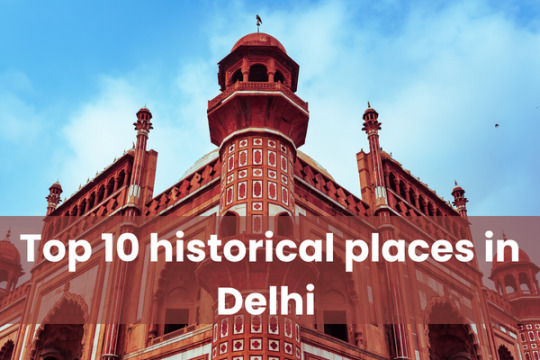
1. Red Fort
The Red Fort, also known as Lal Qila, is one of Delhi's most iconic historical landmarks. Commissioned by Emperor Shah Jahan during the 17th century, it functioned as the primary abode for the Mughal emperors. The fort's stunning red sandstone architecture and intricate design, including the Diwan-i-Aam and Diwan-i-Khas, make it a UNESCO World Heritage Site. A visit to the Red Fort is a step back in time to the grandeur of the Mughal era.
2. Qutub Minar
Qutub Minar is another UNESCO World Heritage Site and a symbol of Delhi's ancient history. This 73-meter-high minaret was built in the 12th century by Qutb-ud-din Aibak. The complex also includes the Quwwat-ul-Islam Mosque, which is one of the earliest mosques in India. The intricate carvings and the impressive height of the Qutub Minar make it a must-visit historical site.
3. Humayun's Tomb
Humayun's Tomb, a majestic Mughal mausoleum, is a testament to the exquisite Mughal architecture. Built in the mid-16th century, it predates the Taj Mahal and is often considered a precursor to it. The beautifully landscaped gardens and the tomb's symmetrical design are its defining features. It is also a UNESCO World Heritage Site and a place of serenity and historical significance.
4. India Gate
India Gate is a war memorial and an iconic symbol of Delhi. It was built in honor of the soldiers who sacrificed their lives during World War I. The Amar Jawan Jyoti, an eternal flame, is situated under the arch and represents the sacrifices made by the Indian Armed Forces. The lush green lawns around India Gate make it a popular spot for picnics and evening walks.
5. Jama Masjid
Jama Masjid is one of the largest mosques in India and an architectural masterpiece of the Mughal era. Commissioned by Shah Jahan, the mosque can accommodate over 25,000 worshippers. Its red sandstone and white marble construction, along with the stunning views from its minarets, create an awe-inspiring atmosphere. Visitors can also explore the bustling markets of Old Delhi surrounding the mosque.
6. Lotus Temple
The Lotus Temple is a modern architectural marvel and a symbol of religious harmony. Shaped like a lotus flower, it is a Bahá'í House of Worship where people of all faiths are welcome to meditate and pray. The structure is made of white marble and is surrounded by lush gardens, creating a serene and contemplative environment.
7. Akshardham Temple
Swaminarayan Akshardham Temple is a sprawling complex dedicated to spirituality and art. It houses the Akshardham Mandir, a magnificent temple with intricate carvings, and the Yagnapurush Kund, the world's largest stepwell. The temple also features exhibitions and light and sound shows that narrate India's rich cultural and spiritual heritage.
8. National Museum
The National Museum in Delhi is a treasure trove of historical artifacts, art, and sculptures. It showcases India's rich cultural heritage through its extensive collection. From ancient archaeological finds to medieval and modern art, the museum provides a comprehensive view of India's history and artistic evolution.
9. Tughlaqabad Fort
Tughlaqabad Fort, built by Ghiyas-ud-din Tughlaq in the 14th century, is a massive fortress that reflects the architectural prowess of the Tughlaq dynasty. The fort's ruins are a striking sight, with its imposing walls and the tomb of Ghiyas-ud-din Tughlaq. Exploring this fort is like stepping into a different era of Delhi's history.
10. Raj Ghat
Raj Ghat is a simple yet profound memorial to Mahatma Gandhi, the father of the nation. It is a black marble platform marking the spot of his cremation in 1948. Surrounded by beautifully maintained gardens, Raj Ghat is a place of reflection and homage to the great leader who played a pivotal role in India's struggle for independence.
Conclusion
Delhi's historical sites are not just monuments; they are windows into India's rich and diverse history. From the grandeur of the Mughal era to the architectural marvels of modern times, the top 10 historical places in Delhi offer a captivating journey through the ages. Whether you're interested in architecture, art, spirituality, or simply exploring the past, Delhi's historical treasures have something to offer every visitor. So, plan your trip to Delhi and immerse yourself in the city's remarkable heritage.
1 note
·
View note
Text
Heritage Hues: A Journey from Guntur to Hyderabad
Are you planning to visit Hyderabad?? Nuego is ready to make your travel worth every minute till you reach this cosmopolitan. The Guntur to Hyderabad voyage is nothing short of visually pleasing and dynamic topography, from agricultural fields to small towns. The experience can be a mix of tranquility during the stretches of open roads and lively interactions during stops in towns. Nuego efficient, safe, and luxurious e-bus services will catalyze the experience even more.
Guntur to Hyderabad distance
A 7-hour bus journey to the destination, Guntur to Hyderabad is around 300 km journey. Neugo’s efficient, safe, and luxurious e-bus services will ensure that this experience is enjoyable and comfortable for you.

Lesser-known but fascinating things to explore in Hyderabad
Street Food Secrets: Venture beyond popular food joints to explore the hidden street food gems. Try local specialties like Osmania biscuits, Irani chai, and regional snacks in lesser-known markets.
Golconda's Whispering Gallery: While Golconda Fort is a major attraction, few know about the incredible acoustics of the "Whispering Gallery." Even a gentle whisper at one end can be heard clearly at the other, highlighting ancient architectural marvels.
Qutb Shahi Heritage Park: Often overshadowed by Golconda Fort, the Qutb Shahi Heritage Park is a serene complex with tombs of the Qutb Shahi rulers. It offers a tranquil and historical atmosphere away from the crowds.
Heritage Walks in Old City: Explore the narrow lanes of the Old City on a heritage walk. Discover hidden havelis, and ancient mosques, and get a feel of the city's rich history.
Dine with a View at Necklace Road: Instead of typical restaurants, consider dining at one of the eateries along Necklace Road for a beautiful view of the Hussain Sagar Lake.
Laser Show at Lumbini Park: While Lumbini Park is known for its musical fountain, the laser show in the evening is a unique visual experience that often goes unnoticed.
Hidden Art Galleries: Seek out lesser-known art galleries and cultural spaces. The city has thriving contemporary art scenes beyond the mainstream galleries.
Nature Trails in Mrugavani National Park: Escape the urban hustle and explore Mrugavani National Park for nature trails, bird watching, and a serene environment, often overlooked by traditional itineraries.
Bike Tours of the City: Opt for a bike tour instead of traditional sightseeing. It allows you to explore neighborhoods at a leisurely pace, discovering hidden corners and interacting with locals.
Visit Numaish Exhibition: If your visit coincides with the Numaish Exhibition, attend this annual event that showcases a wide variety of products, from traditional crafts to modern gadgets.
Explore Puppetry at Salar Jung Museum: While the Salar Jung Museum is famous, not many know about the traditional puppetry performances that occasionally take place, adding a cultural touch to your visit.

Exploring these less-trodden paths can add a layer of authenticity and discovery to your Hyderabad experience. Don't hesitate to venture off the beaten path and create your unique memories in this historic city. Visit the Nuego site to check the bus timings from Guntur to Hyderabad and book your tickets now. Avail the discount and cashback offers on your bookings!
0 notes
Text
Qila Rai Pithora, Delhi: A Historical Tapestry of an Ancient Fort
Qila Rai Pithora, often referred to as the first city of Delhi, stands as an ancient testament to the city's rich and diverse history. Located in the heart of India's capital, this fort carries within its walls a storied past that reflects the rise and fall of empires and the evolution of an era. In this article, we will journey back in time to explore the historical tapestry of Qila Rai Pithora and its enduring significance.
Origins and Naming
Qila Rai Pithora owes its origins to the reign of Prithviraj Chauhan, a powerful Rajput king of the Chahamana dynasty. He established this fort in the 12th century, making it a strategic stronghold for his kingdom. It was initially named "Lal Kot" or the Red Fort due to the extensive use of red sandstone in its construction. Later, the fort was further fortified and expanded by subsequent rulers.
Architectural Marvels
The architectural marvels of Qila Rai Pithora showcased a blend of Hindu and Islamic influences. The fort was fortified by massive walls and gates, with intricate carvings and designs adorning the structures. The fortifications were a testimony to the engineering prowess of that era.
Within the fort, there were palaces, temples, residential areas, and public buildings, each showcasing the opulence and grandeur of the time. The Qila Rai Pithora complex also housed a stunning victory tower known as the Qutub Minar, which was commissioned by Qutb-ud-din Aibak, one of the early rulers of the Slave Dynasty.
The Rise and Fall
The fort of Qila Rai Pithora witnessed the highs and lows of medieval Indian history. Prithviraj Chauhan's reign was marked by prosperity and stability, but it eventually faced challenges from the ambitious Muhammad Ghori, leading to the infamous battles of Tarain. Following Prithviraj Chauhan's defeat, the fort came under the rule of the Delhi Sultanate and various other dynasties.
Over time, Qila Rai Pithora fell into decline due to subsequent invasions, sieges, and shifting power dynamics. It was later overshadowed by newer forts and cities built within Delhi, eventually leading to its abandonment and subsequent ruin.
Present and Preservation
Today, what remains of Qila Rai Pithora are the ruins and remnants of its former glory. The site is recognized as a significant archaeological heritage and is protected by the Archaeological Survey of India (ASI). Visitors can explore the ruins, witness the surviving architectural elements, and imagine the grandeur of the past.
Despite the ravages of time, Qila Rai Pithora holds a unique historical and architectural value. Its existence is a reminder of the rich tapestry of Delhi's history, showcasing the ever-changing dynasties and influences that shaped the region over centuries.
Conclusion
Qila Rai Pithora, the first city of Delhi, remains a fascinating historical site, offering a glimpse into India's medieval past. As we walk through its ruins, we can imagine the grandeur and splendor that once graced this ancient fort, appreciating the architectural prowess and rich history that continue to captivate the imagination of historians and visitors alike.
0 notes
Text
Qutub Minar and its monuments
Context: The initial stage of restoration efforts for the Alai Darwaza (at Qutub Minar complex) will be undertaken by the Archaeological Survey of India.
Alai Darwaza
Originally, Qutb-ud-din Aibak commissioned the construction of a mosque, later partly expanded by Shamsuddin Altamash (Iltutmish).
Alauddin Khilji had grand plans for the Qutub complex, aiming to enlarge the Quwwat-ul-Islam…

View On WordPress
1 note
·
View note
Text
The Majestic Qutub Minar: A Testament to Timeless Beauty
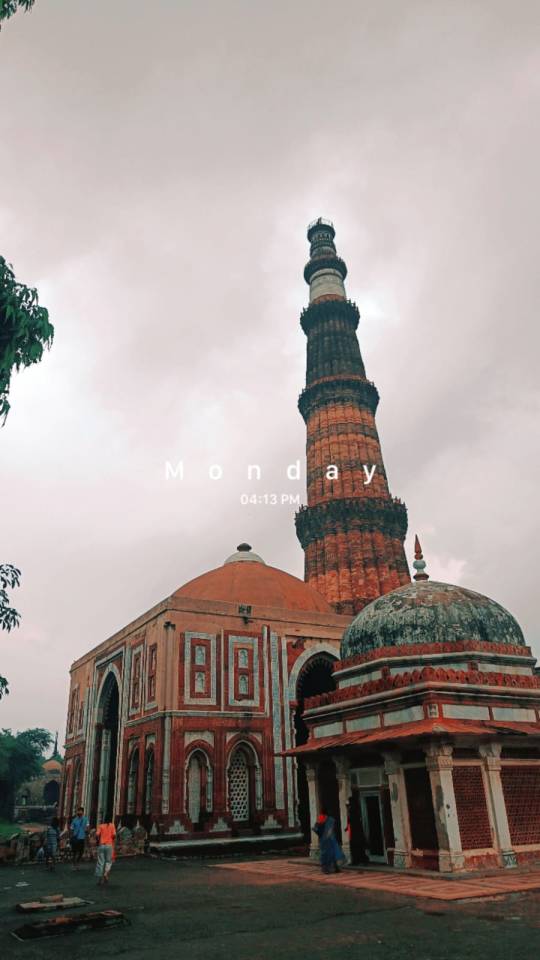
In this blog, I will tell how I got attracted to history and its heritage. It was the Monday afternoon of 1oth July 2023, I took the nearest metro from my home and reached the Qutab Minar metro station. From the metro station, I covered the distance of 1km barefoot. After a long wait in the ticket queue, when I entered the Qutab complex I felt lost inside the historical monuments. It was this visit to Qutab Complex that sparked my interest in heritage. It made me fall in love with history, heritage, art, and architecture. The first thing which I saw in the Qutab complex was the Quwwat-ul-Islam Mosque. It is located in the center of the quadrangular court. The mosque embodied in itself a definite portion of a demolished Hindu temple up to the plinth level, the extent of which appears to coincide with that half of the mosque around the gateways. The courtyard is surrounded by pillars , noteworthy for their resplendently-carved temple ceilings.
Historical Significance:
Qutub Minar, designated as a UNESCO World Heritage Site, holds great historical importance in India. Built in the early 13th century, it stands as a masterpiece of Indo-Islamic architecture. The towering minaret, reaching a height of 73 meters (240 feet), was constructed by Qutb al-Din Aibak, the first ruler of the Delhi Sultanate. It served as a victory tower commemorating his triumph over the last Hindu kingdom in Delhi.
Architectural Brilliance:
Qutub Minar exemplifies the fusion of different architectural styles, predominantly showcasing Islamic influences. The minar is constructed using red sandstone and features five distinct stories, each adorned with intricate carvings and verses from the Holy Quran. The exquisite calligraphy and delicate geometric patterns that embellish the structure are a testament to the craftsmanship of that era.

Qutub Complex:
Beyond the Qutub Minar itself, the surrounding complex houses several other notable structures. The Alai Darwaza, an imposing entrance gate, is a prime example of Indo-Islamic architecture. Its intricate latticework and calligraphic inscriptions are a visual delight. Additionally, the Tomb of Iltutmish, the Alai Minar (an unfinished minaret), and the Madrasa of Qutbuddin Bakhtiar Kaki are significant attractions within the complex.
Visiting Qutub Minar:
A trip to Qutub Minar is a mesmerizing experience for history enthusiasts, architecture aficionados, and anyone seeking a glimpse into India's rich past. The monument is easily accessible by road and has ample parking facilities. As you stroll through the complex, the aura of antiquity and the sheer magnificence of the architecture will leave you spellbound.

Conclusion:
Qutub Minar, with its towering presence and architectural grandeur, stands as an awe-inspiring testament to India's rich heritage. It showcases the seamless blend of different cultures and serves as a reminder of Delhi's historical significance. A visit to this iconic landmark is not only a visual treat but also an opportunity to connect with the past and marvel at the artistic brilliance of our ancestors. Qutub Minar truly stands tall as a timeless masterpiece, captivating visitors from around the world and etching its indelible mark on the annals of history.
1 note
·
View note
Text
Land Surveying the Pulse of Hyderabad: Uncovering the Dynamic Landscapes that Shape the City's Identity
In the bustling city of Hyderabad, the ever-changing landscapes play a vital role in shaping the city's identity. Behind the scenes, there are dedicated professionals who meticulously survey the land, capturing its essence and providing valuable information to support the city's growth. Land surveying is an age-old practice that has evolved significantly with time, leveraging modern technology to uncover the intricacies of the land. In this article, we will delve into the world of land surveying and explore its significance in understanding the dynamic landscapes that define Hyderabad.
Introduction
Land surveying is an essential discipline that involves the measurement and mapping of the Earth's surface. It plays a critical role in various industries, including urban planning, construction, real estate, and infrastructure development. By employing precise techniques and advanced equipment, land surveyors contribute to the accurate depiction of land boundaries, topography, and spatial data. In Hyderabad, a city renowned for its rich heritage and rapid growth, land surveying serves as the foundation for the city's development.
The Importance of Land Surveying
Before we dive deeper into the specifics of land surveyor in Hyderabad, it is crucial to understand its importance. Land surveying provides valuable insights into the characteristics and dimensions of a particular piece of land. It helps identify boundaries, measure distances, and determine elevations. These measurements are critical for planning and development, as well as legal purposes such as property ownership and resolving disputes. Land surveying acts as a compass that guides the growth and expansion of a city.
The Evolution of Hyderabad's Landscapes
To comprehend the present state of Hyderabad's landscapes, we must explore its historical background and observe how urbanization and infrastructure development have transformed the city.
Historical Background
Hyderabad has a rich historical legacy, dating back to the reign of the Qutb Shahi dynasty and the Mughal era. The city's iconic structures, such as the Charminar and Golconda Fort, stand as testaments to its glorious past. The land surveyors of that era played a crucial role in delineating boundaries and mapping the city's architecture, ensuring the preservation of its cultural heritage.
Urbanization and Expansion
In recent decades, Hyderabad has experienced rapid urbanization, driven by factors such as economic growth, migration, and the establishment of technology parks. As the city expanded, land surveyors played a pivotal role in mapping new residential and commercial areas, identifying potential sites for infrastructure development, and managing the growing complexity of land ownership.
Infrastructure Development
The growth of Hyderabad's infrastructure has been remarkable, with the city witnessing the construction of highways, flyovers, metro rail networks, and IT parks. Land surveyors have been instrumental in surveying the land, ensuring precise measurements, and providing critical data to architects, engineers, and urban planners. Their work enables the efficient planning and execution of large-scale projects that shape the city's physical infrastructure.
The Role of Land Surveyors
Land surveyors are the unsung heroes who work diligently to unravel the intricacies of the land. Let's explore their key responsibilities and the impact they have on Hyderabad's growth.
Defining Boundaries and Ownership
One of the primary tasks of land surveyors is to establish accurate land boundaries. They use advanced surveying techniques to precisely measure and mark the borders between properties. By doing so, they ensure clarity in property ownership, preventing conflicts and legal disputes. The work of land surveyors brings a sense of security and stability to the city's real estate sector.
Planning and Development
Land surveyors are indispensable in the planning and development of new projects. They assess the feasibility of proposed construction sites, analyze the terrain, and provide valuable information regarding land conditions, including soil stability and drainage patterns. This data is crucial for architects, engineers, and urban planners to make informed decisions and optimize the design and layout of structures.
Ensuring Legal Compliance
In Hyderabad, where property transactions are frequent, land surveyors play a critical role in ensuring legal compliance. They verify the authenticity of property documents, survey land for encroachments, and provide accurate measurements for land registration purposes. Their expertise helps maintain the integrity of the real estate market and prevents fraudulent practices.
Technological Advancements in Land Surveying
Land surveying has evolved significantly over the years, embracing technological advancements that have revolutionized the field. Let's explore some of the cutting-edge tools and techniques employed by land surveyors in Hyderabad.
Global Positioning System (GPS)
GPS technology has transformed land surveying by enabling precise positioning and navigation. Land surveyors use GPS receivers to obtain highly accurate location data, allowing them to map large areas quickly and efficiently. GPS technology also aids in establishing control networks, which serve as reference points for subsequent surveys.
Geographic Information System (GIS)
GIS technology combines land surveying data with geospatial information, providing a powerful tool for analysis and decision-making. Land surveyors in Hyderabad utilize GIS software to integrate survey data with other relevant information, such as land records, satellite imagery, and infrastructure databases. This integration enhances the understanding of land characteristics and aids in urban planning.
Remote Sensing and Aerial Surveys
Remote sensing techniques, including satellite imagery and aerial surveys, have revolutionized land surveying practices. These methods allow surveyors to capture large-scale data quickly and accurately. In Hyderabad, aerial surveys are often conducted to gather information on terrain, vegetation, and land use patterns. This data assists in infrastructure planning, environmental impact assessments, and monitoring urban growth.
Challenges in Land Surveying
While land surveying is indispensable for understanding and shaping the landscapes of Hyderabad, it is not without its challenges. Let's explore some of the hurdles faced by land surveyors in this dynamic city.
Rapid Urbanization
The rapid pace of urbanization in Hyderabad presents unique challenges for land surveyors. The city's expansion often outpaces the surveying process, leading to incomplete or outdated data. Land surveyors must work diligently to keep up with the evolving landscape, conducting surveys and updating records to ensure accuracy in the face of rapid urban growth.
Encroachments and Illegal Constructions
One of the significant challenges faced by land surveyors in Hyderabad is the prevalence of encroachments and illegal constructions. Unscrupulous individuals often disregard land boundaries and construct buildings on public or private land unlawfully. Land surveyors play a crucial role in identifying and addressing such encroachments, ensuring that the integrity of land ownership is maintained.
Environmental Considerations
As Hyderabad continues to grow, environmental considerations have become increasingly important in land surveying. The city's natural resources, including water bodies, forests, and green spaces, must be preserved and integrated into urban planning efforts. Land surveyors are involved in assessing environmental impacts, recommending mitigation measures, and promoting sustainable land use practices.
The Impact of Land Surveying on Hyderabad's Growth
The work of land surveyors has a profound impact on Hyderabad's growth and development. Let's explore how land surveying influences key aspects of the city's evolution.
Urban Planning and Infrastructure
Land surveying forms the foundation of urban planning in Hyderabad. Precise land measurements and data allow urban planners to design efficient road networks, optimize infrastructure placement, and plan for future development. By incorporating accurate survey data into urban planning processes, Hyderabad can create well-designed, sustainable, and livable spaces for its residents.
Land Acquisition and Development Projects
Land surveying plays a crucial role in land acquisition for development projects. Whether it's the construction of commercial complexes, residential layouts, or public infrastructure, surveyors accurately identify land boundaries and measure the extent of the land to be acquired. Their work ensures a fair and transparent process, benefiting both developers and landowners.
Property Ownership and Disputes
Land surveying is instrumental in resolving property ownership disputes in Hyderabad. By conducting detailed surveys and establishing accurate boundaries, surveyors help settle conflicts related to land ownership and boundaries. This ensures that individuals and businesses can confidently invest in properties, knowing that their rights and interests are protected.
Conclusion
Land surveying is the pulse that beats beneath the dynamic landscapes of Hyderabad. It provides the critical data and insights necessary for the city's growth, urban planning, and development. From defining boundaries to supporting infrastructure projects, land surveyors are the driving force behind Hyderabad's physical transformation. With advancements in technology and a commitment to accuracy, land surveying continues to shape the city's identity, ensuring a sustainable and prosperous future.
0 notes
Text
History of Qutub Minar
The Qutb Minar was built over the ruins of the Lal Kot, the citadel of Dhillika.[7] Qutub Minar was begun after the Quwwat-ul-Islam Mosque. Drawing references from their Ghurid homeland, Qutub-ud-Din Aibak and Shamsu’d-Din Iltutmish constructed a minar (minaret) at the south-eastern corner of the Quwwatu’l-Islam between 1199 and 1503.[14]
It is usually thought that the tower is named for Qutb-ud-din Aibak, who began it. It is also possible that it is named after Khwaja Qutbuddin Bakhtiar Kaki a 13th-century sufi saint, because Shamsuddin Iltutmish was a devotee of his.[15]

The Minar is surrounded by several historically significant monuments of the Qutb complex. Quwwat-ul-Islam Mosque, to the north-east of the Minar was built by Qutub-ud-Din Aibak in A.D. 1199. It is the earliest extant - mosque built by the Delhi Sultans. It consists of a rectangular courtyard enclosed by cloisters, erected with the carved columns and architectural members of 27 Jain and Hindu temples, which were demolished by Qutub-ud-Din Aibak as recorded in his inscription on the main eastern entrance.[16] Later, a lofty arched screen was erected, and the mosque was enlarged, by Shams-ud- Din Itutmish (A.D. 1210-35) and Ala-ud-Din Khalji. The Iron Pillar in the courtyard bears an inscription in Sanskrit in Brahmi script of fourth century A.D., according to which the pillar was set up as a Vishnudhvaja (standard of god Vishnu) on the hill known as Vishnupada in memory of a mighty king named Chandra.[16]
The mosque complex is one of the earliest that survives in the Indian subcontinent.[6][7]
The nearby pillared cupola known as "Smith's Folly" is a remnant of the tower's 19th century restoration, which included an ill-advised attempt to add some more stories.[17][18]
In 1505, an earthquake damaged Qutub Minar; it was repaired by Sikander Lodi. On 1 September 1803, a major earthquake caused serious damage. Major Robert Smith of the British Indian Army renovated the tower in 1828 and installed a pillared cupola over the fifth story, creating a sixth. The cupola was taken down in 1848, under instructions from The Viscount Hardinge, who was the Governor General of India. at the time. It was reinstalled at ground level to the east of Qutb Minar, where it remains. This is known as "Smith's Folly".[19]
It was added to the list of World Heritage Site by UNESCO in 1993.
The construction of the Qutb Minar was planned and financed by the Ghurids, who emigrated to India and brought Islam with them. The Ghurids, historically known as the Shansabanis, were a clan of Tajik origin that hailed from Ghur, the mountainous region of modern-day western Afghanistan.[20] In the late eleventh century to the early twelfth century, the different sects of this nomadic clan united, losing its nomadic culture. During this time, they also converted to Islam.[20]
They then expanded into modern-day India and quickly took control of a substantial part of the country.[20] The Ghurids annexed the Multan and Uch in the western Punjab in 1175-76, the northwestern regions around Peshawar in 1177, and the region of Sindh in 1185-86. In 1193, Qutb al-Din Aibek conquered Delhi and implemented a Ghurid governorship in the province, and the congregational mosque, the Qutb Minar complex, was founded in 1193.[20] In the past, scholars believed that the complex was constructed to promote a conversion to Islam amongst the Ghurids' new subjects as well as a symbol of the Ghurids' adherence to a socio-religious system.[20] There is now new information to suggest that conversion to Islam was not a top priority of the new annexes and instead the Ghurid governors sought to make a synthesis of the local culture and Islam through negotiation.[20]
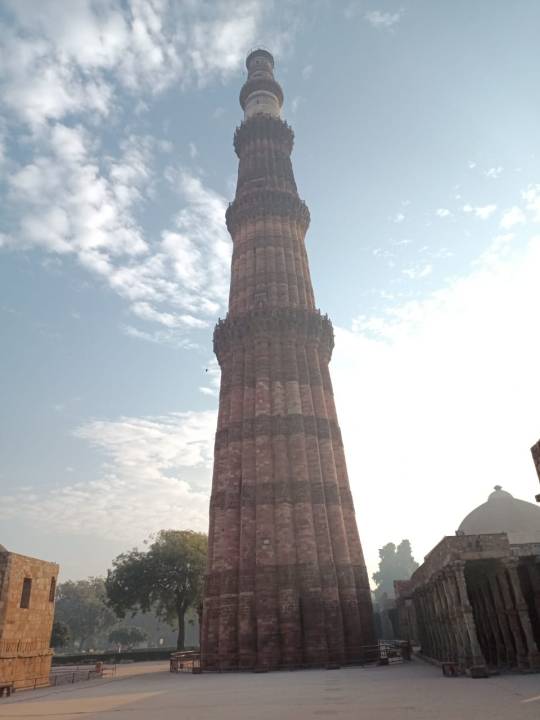
a deputy of Muhammad of Ghor, who founded the Delhi Sultanate after Muhammad of Ghor's death, started construction of the Qutb Minar's first story in 1199. Aibak's successor and son-in-law Shamsuddin Iltutmish completed a further three stories.[15] After a lightning strike in 1369 damaged the then top story, the ruler at the time, Firuz Shah Tughlaq, replaced the damaged story and added one more. Sher Shah Suri also added an entrance while he was ruling and the Mughal emperor Humayun was in exile.[1]
The Qutb Minar consists of five stories of red and grey sandstone. The lowest story, also known as the basement story, was completed during the lifetime of Ghiyeth al-Din Muhammad, a sultan during the Ghurid dynasty.[27]
It is revetted with twelve semicircular and twelve flanged pilasters that are placed in alternating order.[27] This story is separated by flanges and by storied balconies, carried on Muqarnas corbels.[24] The story is placed on top of a low circular plinth that is inscribed with a twelve-pointed star with a semicircle placed with each of the angles between the star’s points.[27]

There are also six horizontal bands with inscriptions inscribed in naskh, a style of Islamic calligraphy, on this story. The inscriptions are as follows: Quran, sura II, verses 255-60; Quran, sura LIX, verses 22-23, and attributes of God; The name and titles of Ghiyath al-Din; Quran, sura XLVIII, verses 1-6; The name and titles of Mu’izz al-Din; and Qur’anic quotations and the following titles in this much restored inscription: "The Amir, the most glorious and great commander of the army."[27] This level also has inscriptions praising Muhammad of Ghor, the sultan of the Ghurids.[15]
The Second, Third, and Fourth Stories
The second, third, and fourth stories were erected by Sham ud-Din Iltutmish, the first Muslim sovereign to rule from Delhi.[28] He is considered to be the first of the Delhi Sultan dynastic line.[28] The second and third stories are also revetted with twelve semicircular and twelve flanged pilasters that are placed in alternating order.[27] These red sandstone columns are separated by flanges and by storied balconies, carried on Muqarnas corbels.[24] Prior to its reconstruction and reduction, the fourth story was also decorated with semicircular pilasters.[27] It was re-constructed in white marble and is relatively plain.[24]
The Fifth Story
In 1369, the fourth story was repaired after lightning struck the minaret. During reconstruction, Sultan Firuz Shah Tughlaq elected to reduce the size of the fourth story and then separated it into two stories.[28]
1 note
·
View note
Text
The ancient Iron Pillar of Dehli, which was forged with exceptionally pure iron and is resistant to rust, reflects the remarkable skill of the metallurgists of ancient India.
24 notes
·
View notes
Text
11 Must Visit Places when In Hyderabad
The Eleven Absolute-Must-See Places in Hyderabad
Nestled in the southern part of India, Hyderabad has long been recognized as a hub of innovation. With its roots dating back to the 16th century, when the visionary Muhammad Quli Qutb Shah established the city as the capital of the Golconda Sultanate, Hyderabad has a rich cultural heritage that continues to thrive to this day.
This vibrant city is renowned for many things, including its world-class shopping experience, delectable cuisine, and an abundance of historic mosques and temples that are a testament to the city's illustrious past. However, what truly sets Hyderabad apart is its exquisite collection of precious gems that dazzle the senses and captivate the imagination.
And, of course, no mention of Hyderabad would be complete without paying homage to its most iconic landmark: the majestic Charminar. Erected in 1591, this architectural marvel has stood the test of time and remains an enduring symbol of the city's rich cultural heritage.
Looking to explore the vibrant city of Hyderabad in a unique and exciting way? Why settle for a mundane tour bus or a conventional cab ride when you can embark on an unforgettable adventure on two wheels?
Get ready to feel the wind in your hair and experience the city from a whole new perspective by riding a bike on rent in Hyderabad from our website Boongg Our affordable solutions will provide you with the perfect vehicle to discover Hyderabad's hidden gems and iconic landmarks.
Hyderabad's Top Attractions:
1. Ramoji Film City, India : The film studio and tourist attraction Ramoji Film City may be found in Hyderabad, India. It's one of the biggest in the world and has hosted productions from Hollywood and Bollywood. This vast complex spans over 2,000 acres and is home to over a dozen sound stages, sets, and attractions. Visitors can take part in a variety of interactive experiences based on their favourite films, or they can simply stroll the park and take in the various sights. Ramoji Film City features a wide variety of accommodations, including hotels, restaurants, and shops.
2. Charminar: The Charminar is a monument and mosque in Hyderabad, Telangana, India, and has been termed "the Arc de Triomphe of the East." In 1591, work began on the structure. It is one of the city's most iconic landmarks and has come to represent Hyderabad itself. It is also a World Heritage Site, recognised by UNESCO. The Charminar is located on the eastern bank of the Musi River, which is the opposite bank. Each of its four minarets rises to a height of 48.7 metres from a square foundation.
The building, made of granite and limestone, is decorated with Islamic calligraphy and stucco. Up to 2,000 worshippers can be accommodated in the Charminar's 45 prayer spaces. On Fridays, worshippers continue to visit 45 of the city's authorised prayer sites. The nighttime glow is beautiful and worth seeing.
3. Golconda: The ancient Golconda Fort stands in Hyderabad, India. The fort was commissioned in the 1600s by Muhammad Quli Qutb Shah, monarch of Golconda. The fort's magnificence and excellent acoustics have made it well-known. The palaces, mosques, temples, and gardens inside the fort form a complex web. For two hundred years, the Golconda Sultanate called this fort their home. Aurangzeb, emperor of the Mughals, assaulted the fort and eventually captured it in 1687. Today, the fort attracts tourists from all over the world.
This incredible structure has walls that are 15–18 feet tall and are around 11 kilometres in a circle. This fort is notable for its water system, its "Rahban" cannon, and the Hindu deity that is engraved onto the walls of Ramdas' jail.
4. The Birla Temple: The Birla Mandir in Hyderabad is a stunning Hindu temple that was built in 1976. The hillside of Naubath Pahad, on which the temple is located, is a popular tourist destination in the city. The Hindu god Vishnu is honoured at this temple, which was constructed completely of white marble.
The temple's intricate carvings are a sight to behold. This beautiful temple, which is said to have required the usage of about 2,000 tonnes of white marble from Rajasthan, is a favourite wedding location as well as a tourist attraction for Hindus from all over the world. It combines styles from three distinct regions of India, each of which is well-known in its own right: Rajasthani architecture, Utkal temple architecture, and South Indian architecture.
The temple is home to an 11-foot tall statue of Lakshminarayana, who is ringed by a stunning lotus carving. On the premises, you'll find a temple dedicated to Lord Bhudda in addition to one's dedicated to Venkateswara, "Padmavati," and "Andal."
5. The Salarjung Palace Artefacts: Hyderabad, India, is home to the Salarjung Museum. It is one of the largest museums in the country, housing more than 43,000 artworks, 9,000 manuscripts, and 47,000 volumes. The museum was founded by Nawab Mir Yousuf Ali Khan Salar Jung III, who served as prime minister of Hyderabad State from 1949 until 1956.
The museum displays a wide variety of art forms, including paintings, sculptures, carvings, textiles, manuscripts, metals, and even weaponry. The most famous artwork at the museum is "Veiled Rebecca" by Italian artist Angelo Bronzino. Other well-known works of art include Leonardo da Vinci's "The Last Supper" and a Buddha statue made in China.
The Salarjung Museum is a must-see for anyone with even a passing interest in art or history. It's widely regarded as among India's finest museums, and visitors of all ages will find enough to enjoy there.
6. Gravity Zip: Thrill-seekers of all ages may feel the rush of flying in a safe and controlled atmosphere at Gravity Zip, India's first and only indoor skydiving facility, in the heart of Hyderabad.
If you're looking for an exciting activity in Hyderabad or simply want to experience the city in a new light, Gravity Zip is the way to go.
7. Palace of Chowmahalla: The Chowmahalla Palace in Hyderabad, Telangana, is widely regarded as one of India's finest palaces. It was the official residence of the Nizams of Hyderabad.
Beautiful examples of Indo-Islamic architecture may be found in the four courtyards of Chowmahalla Palace's four main buildings: the Khilwat, Afzal Mahal, Tahniyat Mahal, and Mahtab Mahal. As part of a bigger complex that also features a clock tower, museum, and heritage hotel, the Chowmahalla Palace is an ideal place to learn about Indian history and culture.
8. NTR Garden
Dedicated to the memory of Nandamuri Taraka Rama Rao, a former chief minister of Andhra Pradesh, NTR Gardens is a 36-acre public park in the heart of Hyderabad, India.
The park features a manmade lake with boat rentals, a playground, an amphitheatre, and a food court with options from across the world.
9. Al-Haram Mecca's Masjid: Built in 1694 by Sultan Muhammad Qutb Shah, the Mecca Masjid is one of the oldest and largest mosques in India and is located just a few tens of metres from the historic Charminar. The Mecca Masjid, named after the city of Mecca in Saudi Arabia, the holiest city in Islam, can hold up to ten thousand people and covers an area of twelve acres. The mosque's main prayer hall is 50 m by 35 m and is held up by 270 pillars.
10. Laad Bazaar: The laad market is a historical part of Hyderabad, India, where bangles and other jewellery are sold. The name "laad bazaar" comes from the tradition of ladies visiting the market to buy bangles for their weddings. The stores in the market now sell everything from saris and spices to bangles and beads, making it a popular tourist destination.Laad Market is the place to go if you're looking for authentic Hyderabadi souvenirs.
11.The Biggest Baobab, also known as Hatiyan Jhad: During the era of the Qutub Shahi dynasty, legend has it that Ali Baba and his band of 40 thieves would hide during the day in a cave in the tree's trunk before performing their horrible actions at night.
You have to climb one of the tree's gigantic 27.4 m-diameter trunks to reach the cave in its heart, but there's a little tunnel that's formed between the branches. The tunnel is dark, so a torch is helpful, but the story of the tree's past is well worth the effort.
With its vibrant nightlife and rich legacy, as well as its many historical structures and monuments (including those mentioned above), and its world-famous gastronomy, Hyderabad is a fantastic place to explore authentic Indian culture.
Eleven Must-See Destinations in Hyderabad
Hyderabad, located in southern India, has long been recognised as a centre of innovation. Hyderabad's cultural heritage dates back to the 16th century, when the visionary Muhammad Quli Qutb Shah founded the city as the capital of the Golconda Sultanate, and continues to flourish.
This vibrant city is renowned for many things, including its world-class shopping, delectable cuisine, and abundance of ancient mosques and sanctuaries that attest to its illustrious past. However, what truly distinguishes Hyderabad is its exquisite collection of precious jewels that captivate the senses and the imagination.
Moreover, no discussion of Hyderabad would be complete without mentioning its most recognisable landmark: the majestic Charminar. This architectural marvel, built in 1591, has withstood the passage of time and continues to represent the city's rich cultural heritage.
Want to discover the vibrant metropolis of Hyderabad in a novel and exciting manner? Why settle for a mundane tour bus or a standard taxi when you can embark on a memorable journey on two wheels?
Prepare to feel the wind in your tresses and gain a new perspective on the city by renting a bicycle in Hyderabad from our website, Boongg. Our cost-effective options will provide you with the ideal vehicle to explore Hyderabad's concealed treasures and famous landmarks.
Top Hyderabad Attractions:
Hyderabad, India is the location of the film facility and tourist attraction Ramoji Film City. It is one of the largest in the globe and has hosted Hollywood and Bollywood productions. This immense complex consists of over a dozen sound stages, sets, and attractions and spans over 2,000 acres. Visitors can participate in a variety of interactive activities based on their beloved films, or they can simply stroll through the park and take in the sights. The accommodations at Ramoji Film City include hotels, restaurants, and retail establishments.
Charminar is a monument and mosque located in Hyderabad, Telangana, India, and has been referred to as "the Arc de Triomphe of the East." In 1591, construction on the structure began. It is one of the most recognisable landmarks in the city and has come to symbolise Hyderabad. Also recognised by UNESCO as a World Heritage Site. The Charminar is situated on the opposite bank of the Musi River, on the eastern side. From a square base, each of its four minarets rises to a height of 48.7 metres.
The structure, which is constructed from granite and limestone, is embellished with Islamic calligraphy and stucco. There are 45 prayer locations within the Charminar that can accommodate up to 2,000 worshippers. On Fridays, worshippers continue to tour 45 authorised prayer sites in the city. The glow of the night is magnificent and worthy of observation.
The ancient Golconda Fort is located in Hyderabad, India. Muhammad Quli Qutb Shah, king of Golconda, ordered the construction of the fort in the 1600s. The fort's beauty and exceptional acoustics have contributed to its notoriety. Within the fort, the palaces, mosques, temples, and gardens comprise a complex web. This fort was the residence of the Golconda Sultanate for two hundred years. In 1687, the Mughal emperor Aurangzeb attacked and eventually captured the fort. Today, visitors from all over the world visit the fort.
This remarkable structure has walls that are approximately 11 kilometres in circumference and 15–18 feet tall. This fort is notable for its water system, "Rahban" artillery, and Hindu deity engraved on the walls of Ramdas' prison.
The Birla Mandir in Hyderabad is a magnificent Hindu temple that was constructed in 1976. The hillside of Naubath Pahad where the temple is situated is a prominent tourist attraction in the city. This temple is dedicated to the Hindu deity Vishnu and was constructed entirely of white marble.
The intricate carvings of the temple are a sight to witness. This magnificent temple, which is said to have required the use of approximately 2,000 tonnes of white marble from Rajasthan, is a popular wedding venue as well as a Hindu tourist attraction. It incorporates well-known architectural styles from three distinct regions of India: Rajasthani architecture, Utkal temple architecture, and South Indian architecture.
The temple houses an 11-foot-tall statue of Lakshminarayana encircled by an exquisite lotus carving. In addition to those dedicated to Venkateswara, "Padmavati," and "Andal," there is a temple dedicated to Lord Bhudda on the premises.
5. The Salarjung Palace Artefacts: The Salarjung Museum is located in Hyderabad, India. It is one of the country's largest museums, hosting over 43,000 works of art, 9,000 manuscripts, and 47,000 volumes. Nawab Mir Yousuf Ali Khan Salar Jung III, who served as prime minister of Hyderabad State from 1949 to 1956, established the museum.
The museum exhibits a broad range of art forms, such as paintings, sculptures, carvings, textiles, manuscripts, metals, and even weapons. "Veiled Rebecca" by Italian artist Angelo Bronzino is the most well-known piece in the museum. Other notable artworks include Leonardo da Vinci's "The Last Supper" and a Chinese Buddha statue.
If you have even a fleeting interest in art or history, you must visit the Salarjung Museum. It is regarded as one of the finest museums in India, and visitors of all ages will find something to appreciate there.
At India's first and only indoor skydiving facility, located in the heart of Hyderabad, thrill-seekers of all ages can experience the rush of soaring in a safe and controlled environment.
Gravity Zip is the way to go if you're looking for an exciting activity in Hyderabad or merely want to see the city in a new light.
7. Chowmahalla Palace: The Chowmahalla Palace in Hyderabad, Telangana, is widely regarded as one of the finest residences in India. It was the official residence of Hyderabad's Nizams.
In the four courtyards of Chowmahalla Palace's four principal buildings, the Khilwat, Afzal Mahal, Tahniyat Mahal, and Mahtab Mahal, are beautiful examples of Indo-Islamic architecture. As part of a larger complex that also includes a clock tower, museum, and heritage hotel, the Chowmahalla Palace is an ideal location for studying Indian history and culture.
8. NTR Garden
NTR Gardens is a 36-acre public park in the centre of Hyderabad, India, which is dedicated to the memory of former Andhra Pradesh chief minister Nandamuri Taraka Rama Rao.
The park features an artificial lake with boat rentals, a playground, an amphitheatre, and an international food court.
9. Al-Haram The Mecca Masjid, constructed in 1694 by Sultan Muhammad Qutb Shah, is one of the earliest and largest mosques in India and is located only a few tens of metres from the historic Charminar. The Mecca Masjid, named after Mecca, Saudi Arabia, the holiest city in Islam, can accommodate up to ten thousand people and spans twelve acres. The main prayer chamber of the mosque is 50 metres by 35 metres and supported by 270 columns.
Laad Bazaar is a historical marketplace in Hyderabad, India, where bangles and other types of jewelery are sold. The name "laad bazaar" is derived from the custom of women visiting the market to purchase bangles for nuptials. The shops in the market now sell saris, spices, bangles, and jewellery, transforming it into a popular tourist destination.Laad Market is where you should go to find authentic Hyderabadi souvenirs.
11.The Biggest Baobab, also known as Hatiyan Jhad: During the era of the Qutub Shahi dynasty, legend has it that Ali Baba and his band of 40 thieves would conceal in a cave in the tree's trunk during the day before committing their heinous deeds at night.
To reach the cave within the tree's heart, you must ascend one of its enormous 27.4 m-diameter trunks, but there is a small tunnel formed between the branches. The tunnel is dark, so a torch is recommended, but the tree's history is well worth the effort.
With its vibrant nightlife and rich legacy, as well as its numerous historical structures and monuments (including those mentioned above), and its world-famous cuisine, Hyderabad is an excellent location to experience authentic Indian culture.
If you liked what you read, do not forget to check out more blogs at : https://www.boongg.com/blogs
1 note
·
View note
